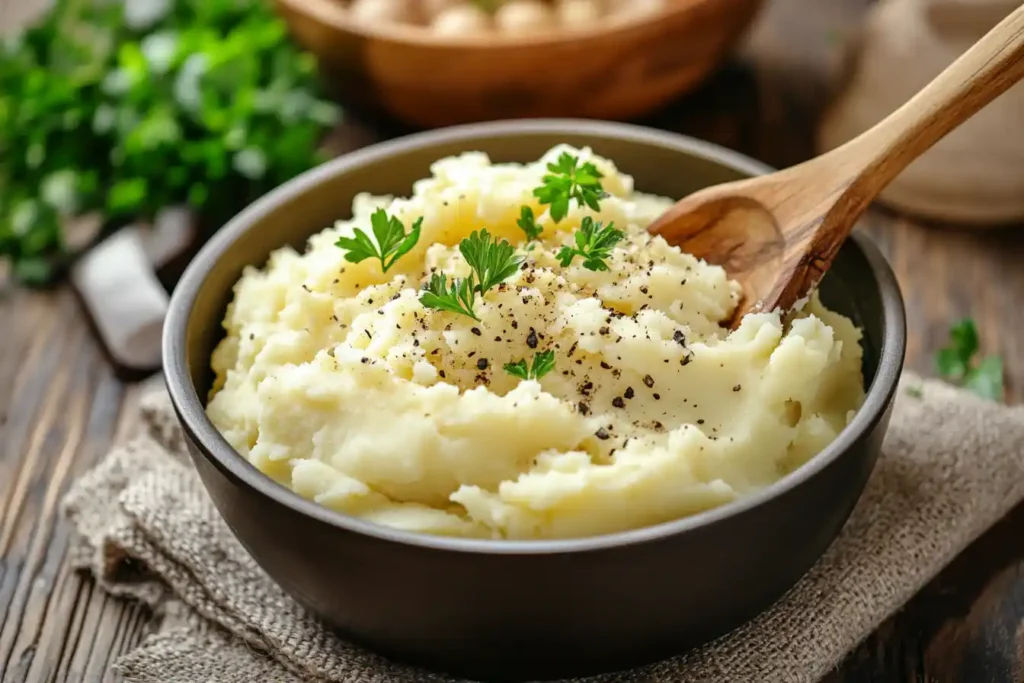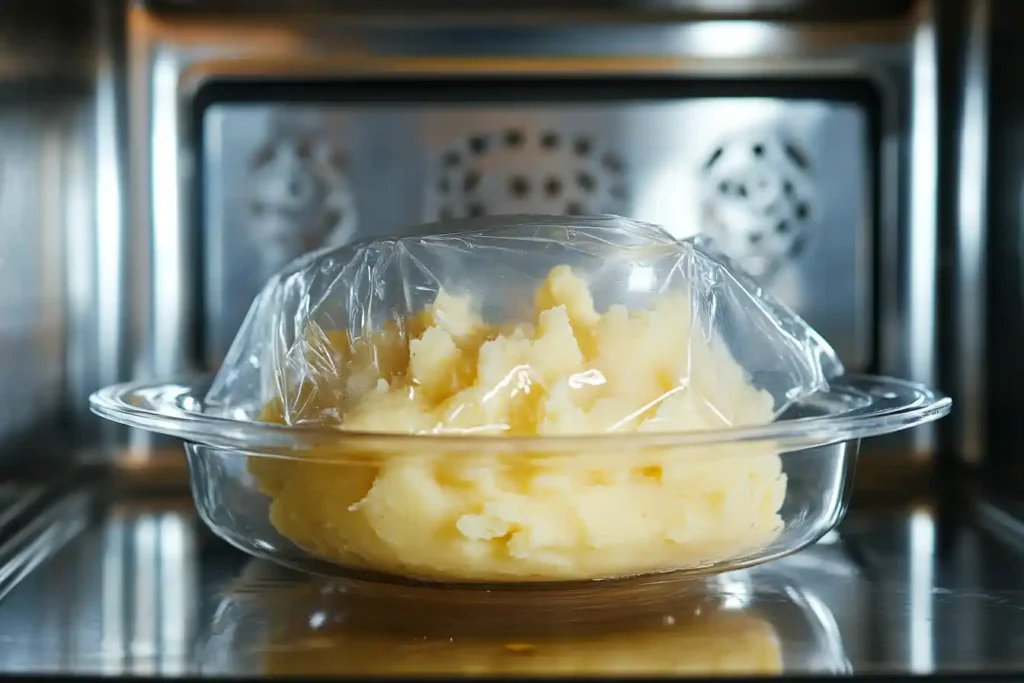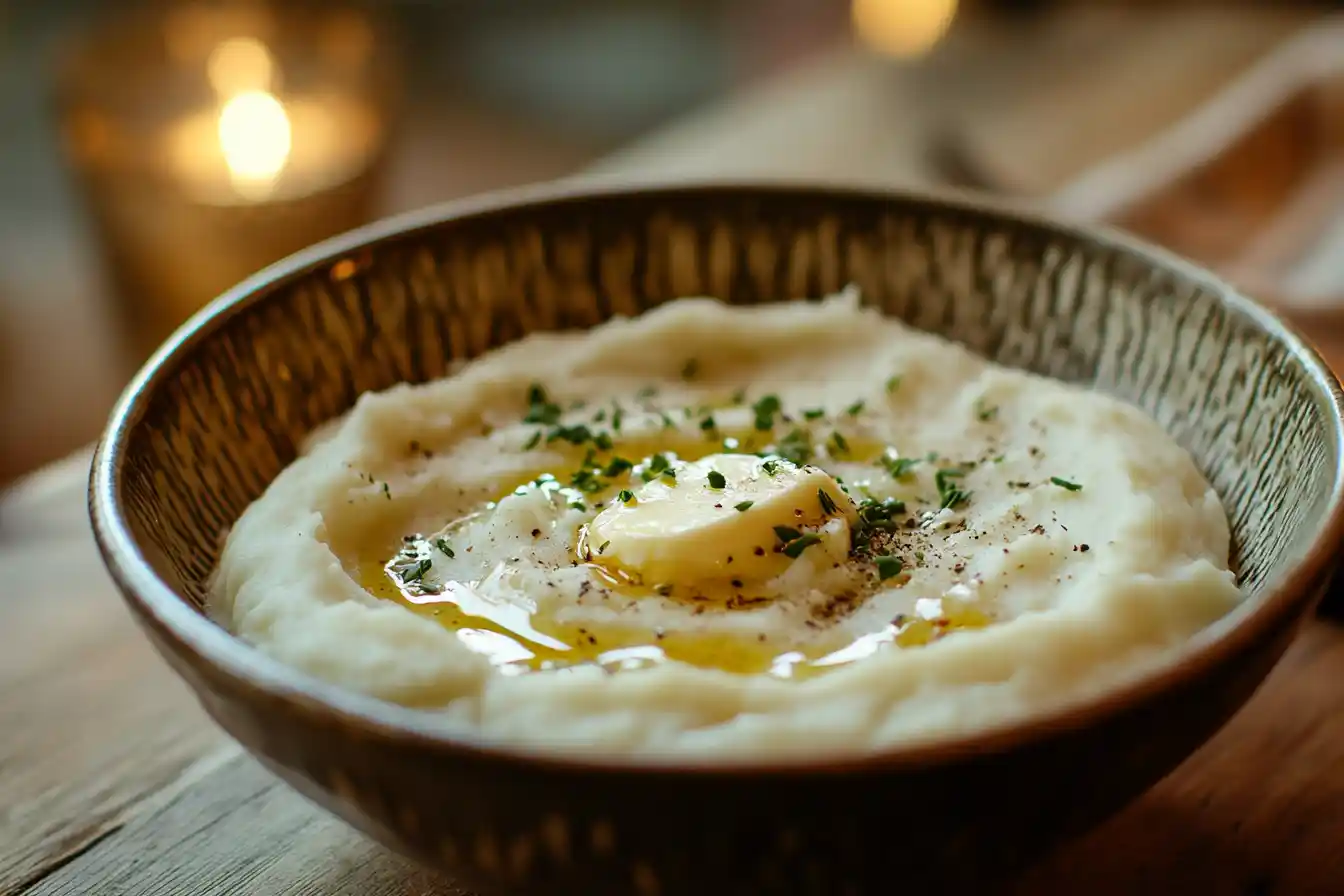Introduction
What is the best way to cook frozen mashed potatoes? Many people turn to frozen mashed potatoes as a quick and convenient side dish for busy meals or holiday feasts. These pre-prepared potatoes save time in the kitchen while delivering rich, creamy flavors when cooked properly. Whether you prefer to use the stovetop, microwave, oven, or slow cooker, there are several ways to heat frozen mashed potatoes while keeping their texture smooth and delicious.
In this guide, we’ll explore the best methods to cook frozen mashed potatoes, including tips for enhancing flavor, preventing dryness, and achieving a homemade taste. By the end, you’ll know exactly how to transform frozen mashed potatoes into a crowd-pleasing dish that’s quick, easy, and satisfying.
Understanding Frozen Mashed Potatoes
What Are Frozen Mashed Potatoes?
Frozen mashed potatoes are pre-cooked and mashed potatoes that are packaged for long-term storage. They often include butter, milk, cream, or seasonings, making them ready to heat and serve.
These potatoes are typically flash-frozen to preserve their flavor and texture, ensuring they taste as fresh as possible when reheated. They come in various forms, including:
- Pre-portioned cubes or scoops: Easy to measure and thaw.
- Solid frozen blocks: Ideal for cooking large batches.
- Ready-to-serve containers: Designed for quick microwave reheating.
Why Choose Frozen Mashed Potatoes?
Frozen mashed potatoes are popular because they:
- Save Time: No need to wash, peel, boil, or mash potatoes.
- Reduce Waste: Pre-portioned servings minimize leftovers.
- Are Convenient: They’re perfect for meal prepping and last-minute dinners.
- Taste Homemade: With the right preparation and enhancements, frozen mashed potatoes can rival fresh ones.
- Versatile Use: They can be customized with ingredients like garlic, cheese, and herbs for added flavor.
Preparing Frozen Mashed Potatoes for Cooking
Thawing Frozen Mashed Potatoes
While some recipes allow you to cook frozen mashed potatoes directly, thawing them first can lead to more even heating and a smoother texture.
Methods for Thawing:
- Refrigerator: Place frozen mashed potatoes in the fridge overnight to defrost slowly.
- Microwave (Quick Thaw): Use the defrost setting and stir occasionally to prevent hot spots.
- Stovetop (Partial Thaw): Heat over low temperature with added liquid, stirring until softened.
Should You Cook Frozen Mashed Potatoes Directly?
Yes, you can cook frozen mashed potatoes directly without thawing, especially if you’re in a hurry. However, be mindful of the following:
- Uneven Heating: Frozen blocks may require frequent stirring to distribute heat.
- Longer Cooking Time: Frozen mashed potatoes take longer to heat through than thawed ones.
- Texture Changes: Direct heating may require adjustments like adding cream or butter to maintain creaminess.
Best Methods to Cook Frozen Mashed Potatoes

1. Stovetop Cooking Method
The stovetop method is one of the most popular ways to cook frozen mashed potatoes because it allows better control over temperature and consistency.
Steps:
- Prepare the Pot: Place a medium saucepan over low to medium heat.
- Add Liquid: Pour in 2–4 tablespoons of milk or cream to prevent the potatoes from sticking and drying out.
- Add Frozen Mashed Potatoes: Place the frozen potatoes directly into the pan.
- Stir Frequently: Stir continuously to distribute heat evenly and break up any lumps as the potatoes thaw.
- Enhance Flavor: Once heated through, stir in butter, cheese, or herbs to taste.
- Serve Warm: Transfer to a serving dish and garnish with chives or parsley for presentation.
Tip: Use a silicone spatula or wooden spoon to prevent scraping the bottom of non-stick pans.
2. Microwave Method

The microwave method is the fastest option, making it ideal for busy schedules.
Steps:
- Prepare a Microwave-Safe Bowl: Add the frozen mashed potatoes to the bowl.
- Add Liquid: Pour in 2–3 tablespoons of milk or water to help retain moisture.
- Cover the Bowl: Use a microwave-safe lid or plastic wrap, leaving a small vent for steam to escape.
- Heat in Intervals: Microwave on high for 2–3 minutes, then stir. Repeat this process until heated through (usually 6–8 minutes total).
- Finish with Seasoning: Stir in butter, cream, or seasoning before serving.
Tip: Avoid overheating to prevent dryness. Stir frequently for even heating.
3. Oven-Baked Method
For larger batches or special occasions, baking frozen mashed potatoes in the oven creates a creamy interior and slightly crispy top layer.
Steps:
- Preheat the Oven: Set the temperature to 350°F (175°C).
- Prepare a Baking Dish: Grease the dish with butter or non-stick spray.
- Layer the Potatoes: Spread the frozen mashed potatoes evenly in the dish.
- Add Toppings (Optional): Sprinkle cheese, breadcrumbs, or herbs for extra flavor.
- Bake Covered: Cover the dish with foil and bake for 20–30 minutes.
- Remove Foil for Crisping: Bake uncovered for an additional 5–10 minutes until the top is golden brown.
Tip: Add an extra splash of milk before baking if the potatoes seem dry.
4. Slow Cooker Method
The slow cooker is perfect for hands-off preparation and keeping mashed potatoes warm during gatherings.
Steps:
- Prepare the Slow Cooker: Grease the interior with butter or non-stick spray.
- Add Frozen Potatoes: Place the frozen mashed potatoes directly into the cooker.
- Add Liquid: Pour in 1/4 cup of milk or broth to prevent dryness.
- Cook on Low: Heat for 2–3 hours, stirring occasionally to ensure even heating.
- Adjust Seasoning: Before serving, stir in butter, cheese, or herbs for added flavor.
Tip: Slow cookers are great for keeping mashed potatoes warm during parties. Simply set the temperature to “warm” after cooking.
5. Steaming Method
Steaming is an excellent choice for preserving the moisture and flavor of frozen mashed potatoes.
Steps:
- Set Up a Steamer Basket: Fill a pot with water and place a steamer basket on top.
- Add Frozen Potatoes: Place the frozen potatoes in the basket and cover with a lid.
- Steam on Medium Heat: Cook for 10–15 minutes or until heated through.
- Stir and Serve: Once soft, stir the potatoes and season as needed.
Tip: Add more milk or butter after steaming to restore creaminess.
Enhancing Frozen Mashed Potatoes for Flavor
Adding Dairy and Creaminess
To make frozen mashed potatoes richer and creamier, consider adding extra dairy. Stir in butter, heavy cream, sour cream, or cream cheese after heating. For a velvety texture, warm the dairy before adding it to prevent cooling the potatoes. You can also use milk or half-and-half for a lighter option. A sprinkle of shredded cheese, such as cheddar or Parmesan, can add depth and richness.
Incorporating Seasonings and Herbs
Seasonings and herbs can elevate the flavor of frozen mashed potatoes, making them taste homemade. Add garlic powder, onion powder, paprika, or nutmeg for a flavorful twist. Fresh herbs like parsley, chives, thyme, or rosemary provide aroma and color. For a bolder flavor, mix in roasted garlic or a dash of hot sauce.
Mixing in Vegetables or Proteins
Enhance frozen mashed potatoes by stirring in vegetables like roasted carrots, peas, or spinach. For protein, consider mixing in bacon bits, crumbled sausage, or shredded chicken. These additions not only boost flavor but also create a more filling dish, perfect for hearty meals.
Tips for Reheating Without Losing Texture
Preventing Dryness or Overcooking
Frozen mashed potatoes can sometimes dry out during reheating. To prevent this, always add a splash of milk, cream, or broth before reheating. Stir frequently to distribute heat evenly and prevent burning at the bottom. For microwaving, cover the dish with a damp paper towel or lid to lock in moisture.
Reviving Creaminess
If the potatoes seem stiff after reheating, revive their texture by stirring in additional butter or cream while warm. A few tablespoons of sour cream or Greek yogurt can also add tanginess and moisture. Avoid adding too much liquid at once to prevent them from becoming runny.
Storage and Leftover Tips
Refreezing After Cooking
While it’s safe to refreeze mashed potatoes after cooking, it’s generally not recommended as repeated freezing can affect texture. Instead, refrigerate leftovers and consume them within 3–4 days for the best taste. If you must refreeze, ensure the potatoes are cooled completely, then portion them into airtight containers or freezer bags for better preservation.
Refrigerating Leftovers
Cooked mashed potatoes can be stored in the refrigerator for up to 4 days. Reheat them using the stovetop, microwave, or oven, adding extra liquid or butter to restore moisture. For quicker reheating, portion leftovers into small servings before storing.
Common Mistakes to Avoid When Cooking Frozen Mashed Potatoes
Overheating and Burnt Edges
One common mistake is overheating frozen mashed potatoes, which can lead to burnt edges or dried-out sections. Always use low to medium heat and stir frequently, especially when using the stovetop or microwave. Avoid high heat, which can cause uneven cooking.
Using Too Much Liquid
Adding too much liquid to frozen mashed potatoes can make them watery and ruin their creamy texture. Start with small amounts of milk or cream and gradually add more if needed. Stir thoroughly to combine before adding additional liquid.
Frequently Asked Questions (FAQs)
1. Can you cook frozen mashed potatoes without thawing them?
Yes, you can cook frozen mashed potatoes without thawing them. Methods like the stovetop, oven, microwave, and slow cooker allow you to heat them directly from frozen. However, cooking times may be slightly longer than thawed potatoes, and it’s important to stir frequently to ensure even heating.
2. How do you make frozen mashed potatoes taste homemade?
To make frozen mashed potatoes taste homemade, add butter, cream, or milk while reheating to improve texture and richness. Enhance flavor with garlic, herbs, cheese, or even a splash of chicken broth. Topping them with bacon bits, chives, or roasted garlic can also create a more gourmet experience.
3. Are frozen mashed potatoes as good as fresh ones?
Frozen mashed potatoes can be nearly as good as fresh ones, especially when cooked and seasoned properly. Using high-quality frozen potatoes and adding flavorful ingredients during reheating can make them taste homemade. Proper storage and preparation also preserve texture and taste.
4. How long can frozen mashed potatoes be stored?
Frozen mashed potatoes can be stored for up to 3 months in the freezer when kept in airtight containers or freezer bags. Be sure to label with the freezing date and follow proper thawing and reheating methods for the best results.
5. What’s the fastest way to cook frozen mashed potatoes?
The microwave is the fastest way to cook frozen mashed potatoes. Simply place them in a microwave-safe bowl, cover with a lid or damp paper towel, and heat in 2–3 minute intervals, stirring in between. This method usually takes 6–8 minutes in total.
6. Can you freeze mashed potatoes after reheating?
It’s not recommended to freeze mashed potatoes again after reheating, as repeated freezing and thawing can make them grainy and affect their texture. Instead, store reheated mashed potatoes in the refrigerator and consume them within 3–4 days.
Conclusion
Cooking frozen mashed potatoes is quick, easy, and highly versatile. Whether you use the stovetop, microwave, oven, slow cooker, or steamer, there’s a method to fit every schedule and preference. Adding dairy, seasonings, and toppings can transform frozen mashed potatoes into a rich, flavorful side dish that tastes homemade.
By following proper storage, reheating techniques, and flavor-enhancing tips, you can enjoy creamy and delicious mashed potatoes without the hassle of making them from scratch. Whether you’re serving them for a holiday feast or a casual weeknight dinner, frozen mashed potatoes can be your go-to solution for convenience and taste.
For more insights on mashed potatoes, explore Are Mashed Potatoes Good After Being Frozen? to learn about storage tips. If you’re considering alternatives, check out Is Frozen Mashed Potato Any Good? for preparation ideas. Also, discover reheating techniques with Can You Cook Meatballs From Frozen?.

